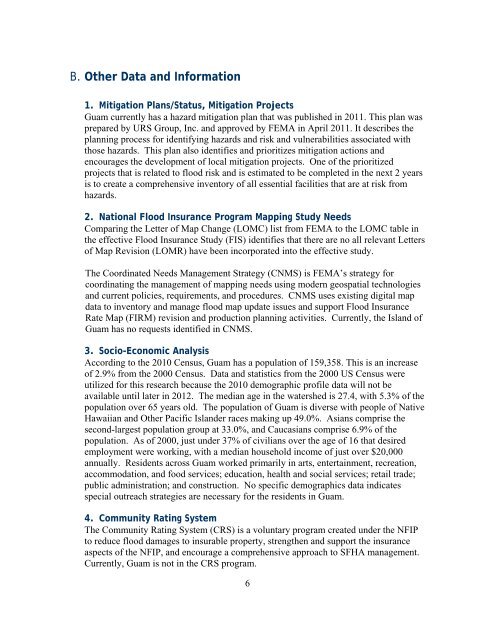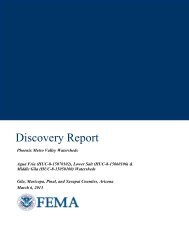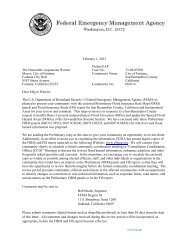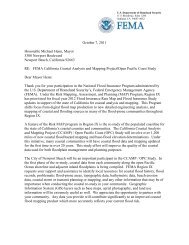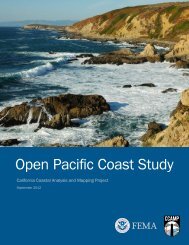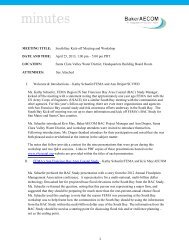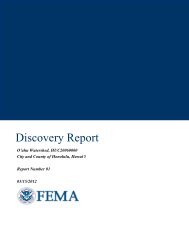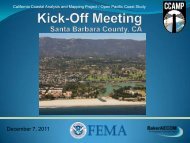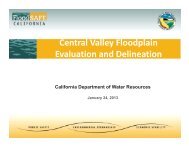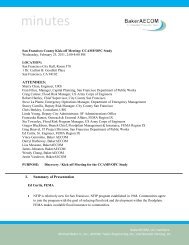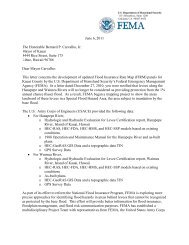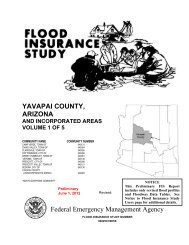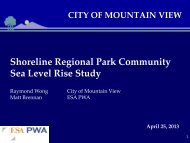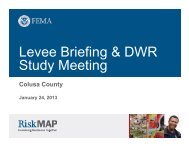Final Guam Discovery Report - FEMA Region 9
Final Guam Discovery Report - FEMA Region 9
Final Guam Discovery Report - FEMA Region 9
- No tags were found...
You also want an ePaper? Increase the reach of your titles
YUMPU automatically turns print PDFs into web optimized ePapers that Google loves.
B. Other Data and Information1. Mitigation Plans/Status, Mitigation Projects<strong>Guam</strong> currently has a hazard mitigation plan that was published in 2011. This plan wasprepared by URS Group, Inc. and approved by <strong>FEMA</strong> in April 2011. It describes theplanning process for identifying hazards and risk and vulnerabilities associated withthose hazards. This plan also identifies and prioritizes mitigation actions andencourages the development of local mitigation projects. One of the prioritizedprojects that is related to flood risk and is estimated to be completed in the next 2 yearsis to create a comprehensive inventory of all essential facilities that are at risk fromhazards.2. National Flood Insurance Program Mapping Study NeedsComparing the Letter of Map Change (LOMC) list from <strong>FEMA</strong> to the LOMC table inthe effective Flood Insurance Study (FIS) identifies that there are no all relevant Lettersof Map Revision (LOMR) have been incorporated into the effective study.The Coordinated Needs Management Strategy (CNMS) is <strong>FEMA</strong>’s strategy forcoordinating the management of mapping needs using modern geospatial technologiesand current policies, requirements, and procedures. CNMS uses existing digital mapdata to inventory and manage flood map update issues and support Flood InsuranceRate Map (FIRM) revision and production planning activities. Currently, the Island of<strong>Guam</strong> has no requests identified in CNMS.3. Socio-Economic AnalysisAccording to the 2010 Census, <strong>Guam</strong> has a population of 159,358. This is an increaseof 2.9% from the 2000 Census. Data and statistics from the 2000 US Census wereutilized for this research because the 2010 demographic profile data will not beavailable until later in 2012. The median age in the watershed is 27.4, with 5.3% of thepopulation over 65 years old. The population of <strong>Guam</strong> is diverse with people of NativeHawaiian and Other Pacific Islander races making up 49.0%. Asians comprise thesecond-largest population group at 33.0%, and Caucasians comprise 6.9% of thepopulation. As of 2000, just under 37% of civilians over the age of 16 that desiredemployment were working, with a median household income of just over $20,000annually. Residents across <strong>Guam</strong> worked primarily in arts, entertainment, recreation,accommodation, and food services; education, health and social services; retail trade;public administration; and construction. No specific demographics data indicatesspecial outreach strategies are necessary for the residents in <strong>Guam</strong>.4. Community Rating SystemThe Community Rating System (CRS) is a voluntary program created under the NFIPto reduce flood damages to insurable property, strengthen and support the insuranceaspects of the NFIP, and encourage a comprehensive approach to SFHA management.Currently, <strong>Guam</strong> is not in the CRS program.6


